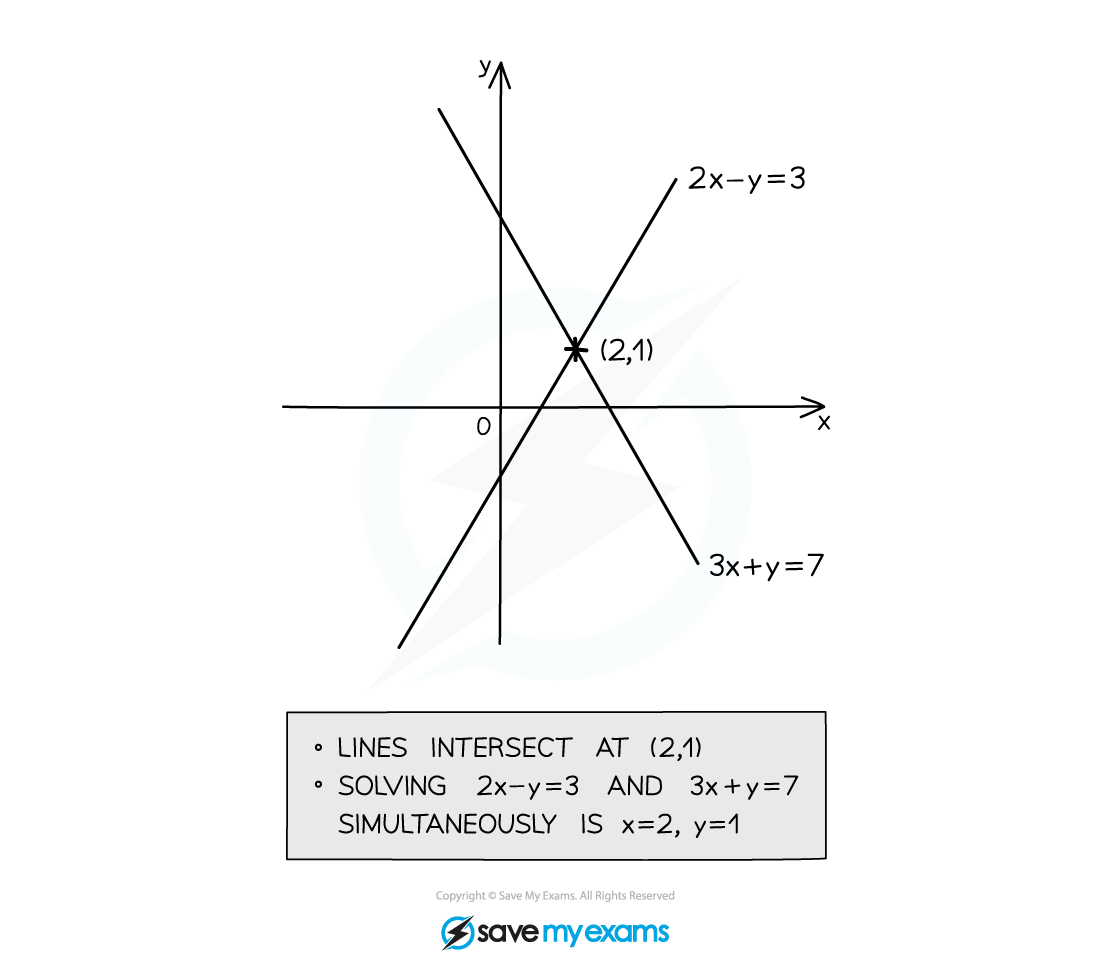Solving Simultaneous Equations (Cambridge (CIE) IGCSE International Maths): Revision Note
Exam code: 0607
Did this video help you?
Linear simultaneous equations
What are linear simultaneous equations?
When there are two unknowns (x and y), we need two equations to find them both
For example, 3x + 2y = 11 and 2x - y = 5
The values that work are x = 3 and y = 1
These are called linear simultaneous equations
Linear because there are no complicated terms like x2 or y2
How do I solve linear simultaneous equations by elimination?
Elimination removes one of the variables, x or y
To eliminate the x's from 3x + 2y = 11 and 2x - y = 5, make the number in front of the x (the coefficient) in both equations the same (the sign may be different)
Multiply every term in the first equation by 2
6x + 4y = 22
Multiply every term in the second equation by 3
6x - 3y = 15
Subtracting the second equation from the first eliminates x
When the sign in front of the term you want to eliminate is the same, subtract the equations
The y terms have become 4y - (-3y) = 7y (be careful with negatives)
Solve the resulting equation to find y
y = 1
Then substitute y = 1 into one of the original equations to find x
3x + 2 = 11, so 3x = 9, giving x = 3
Write out both solutions together, x = 3 and y = 1
Alternatively, you could have eliminated the y's from 3x + 2y = 11 and
2x - y = 5 by making the coefficient of y in both equations the sameMultiply every term in the second equation by 2
Adding this to the first equation eliminates y (and so on)
When the sign in front of the term you want to eliminate is different, add the equations
How do I solve linear simultaneous equations by substitution?
Substitution means substituting one equation into the other
This is an alternative method to elimination
You can still use elimination if you prefer
To solve 3x + 2y = 11 and 2x - y = 5 by substitution
Rearrange one of the equations into y = ... (or x = ...)
For example, the second equation becomes y = 2x - 5
Substitute this into the first equation
This means replace all y's with 2x - 5 in brackets
3x + 2(2x - 5) = 11
Solve this equation to find x
x = 3
Then substitute x = 3 into y = 2x - 5 to find y
y = 1
How do I solve linear simultaneous equations graphically?
Plot both equations on the same set of axes
To do this, you can use a table of values
or rearrange into y = mx + c if that helps
Find where the lines intersect (cross over)
The x and y solutions to the simultaneous equations are the x and y coordinates of the point of intersection
For example, to solve 2x - y = 3 and 3x + y = 4 simultaneously
First plot them both on the same axes (see graph)
Find the point of intersection, (2, 1)
The solution is x = 2 and y = 1

Examiner Tips and Tricks
Always check that your final solutions satisfy both original simultaneous equations!
Write out both solutions (x and y) together at the end to avoid examiners missing a solution in your working.
Worked Example
Solve the simultaneous equations
Answer:
It helps to number the equations
We will choose to eliminate the y terms
Make the y terms equal by multiplying all parts of equation 1 by 3 and all parts of equation 2 by 2
The 6y terms have different signs, so they can be eliminated by adding equation 4 to equation 3
Solve the equation to find x (divide both sides by 23)
Substitute x = 3 into either of the two original equations
Solve this equation to find y
Substitute x = 3 and y = - 2 into the other equation to check that they are correct
Write out both solutions together
This question can also be done by eliminating x first (multiplying equation 1 by 4 and equation 2 by 5 then subtracting)

Unlock more, it's free!
Did this page help you?